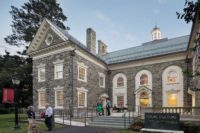Oberlin College, Bibbins Hall
American Gothic: Westlake Reed Leskosky raises the roof in its overhaul of a music building by Minoru Yamasaki.
















Architects & Firms
Oberlin, Ohio
Visitors to Oberlin College in rural northern Ohio might be surprised by the caliber of architecture that graces its nearly 500-acre campus. While architectural tourists have long flocked to another heartland town—Columbus, Indiana—to see its array of built works by modern masters, fewer are familiar with Oberlin's own extensive collection of buildings by leading architects. Designs range from 19th-century Richardsonian Romanesque gems and Cass Gilbert's numerous early-20th-century campus contributions, to innovative and sometimes controversial buildings by Wallace Harrison, Hugh Stubbins, and Robert Venturi from the 1950s through the '70s. One of the more recent additions is William McDonough's Center for Environmental Studies, considered a leading example of green architecture.
Housing music studios and faculty offices, Bibbins's design was structurally and acoustically advanced for its time. But the 50-year-old building, whose exterior walls lacked vapor barriers and suffered from failing joints and deteriorated window caulking, was in need of an overhaul that included full systems and lighting upgrades. Cleveland-based Westlake Reed Leskosky (WRL), the same architecture and engineering firm that completed the adjacent Kohl Building for the conservatory's programs in jazz, music history, and theory in 2010, is overseeing the Bibbins renovation.
A key aspect of the ongoing project, which includes the replacement of all windows and interior perimeter walls, was the creation of a much-needed recital space. The school's initial plans called for combining two classrooms, but the 10-foot ceilings were not high enough to avoid excessive loudness, realize proper sound distribution, or create reverberation (the persistence of sound after it is produced). WRL, together with Oak Park, Illinois'based acousticians Talaske Sound Thinking, quickly realized they would need to locate the space on the third floor and raise the roof.
The design team grappled with a number of aesthetic and structural issues as a result of cutting open a large section of the roof. “The biggest challenge—and this is true for any existing building—is that you never know what you're going to find in the existing structure,” says Stephanie Banfield, senior structural engineer at WRL. “This building was definitely a structural system I had never seen before.”
The 52-foot-wide, 225-foot-long Bibbins features limited interior columns. Instead, the exterior walls, composed of diamond-shaped precast-concrete panels up to 10½ inches thick, with exposed aggregate, serve as the main vertical load-carrying elements. WRL determined that the best way to insert a pop-up while maintaining the roof diaphragm was to use steel trusses that would not require additional vertical supports. “We didn't want a building trying to do the same thing as Yamasaki,” says WRL principal Jonathan Kurtz. “Steel allowed us to do it in a light way that was a counterpoint to the rugged three-dimensional structure.”
Just as Yamasaki's structural system determined the aesthetics of the building, so did the truss within the 24-foot-high, 1,300-square-foot recital space located at the west end of Bibbins. Wood dowels, 5/8 inch in diameter and spaced between 1¼ and 1½ inches apart, were arranged to visually reinforce the diagonals of the trusses. The composition creates a delicate veil on the interior that lets in filtered sunlight during the day through the new clerestory's insulated glazing units. After dark, the transparent box becomes a lantern, with the area below in use at all hours of the night, as both an informal rehearsal area and a recording room.
The maple dowels, however, were not ideal from an acoustic standpoint. In WLR's initial design, these elements were all the same length, which would have caused them to resonate and absorb sound at the same pitch. In extreme cases, this phenomenon would color the sound. “By introducing vertical elements between the diagonals, we basically took dozens of dowels that were the same length and made them different lengths,” says acoustician Rick Talaske. “It avoided a pitch-selective sound absorption and keeps the timbre of instrumental sound natural.”
Elsewhere in the room, sound absorptive and sound diffusive materials—the former to control reverberation and the latter to spread sound out in many directions and produce a pleasant timbre—were integrated behind sound-“transparent” perforated metal panels. Elsewhere in the building, there were a number of good acoustic solutions implemented as part of Yamasaki's original design. Most notably, resiliently supported concrete floor slabs in most of the faculty studios and other sensitive rooms avoid sound transfer vertically and horizontally. “While acoustically isolated construction is standard now, many music buildings of this era were not built that way,” Talaske explains. “Bibbins is exceptional in that regard.”
A rigid connection of the exterior wall and the window frame to the interior construction could cause sound transfer, or flanking, between rooms. To avoid that, new windows are now being resiliently mounted throughout Bibbins. The new interior wall system is similarly isolated from the exterior concrete walls, something that was not included in Yamasaki's design.
Those types of shortcomings add to the complexity of accommodating today's performance standards within a '60s building. While not grand, WRL's intervention succeeds in sensitively inserting contemporary infrastructure into an iconic envelope.
People
Architect:
Engineers:
Consultants:
General Contractor:
Client:
Size:
Construction Cost:
Completion date: |
Products
Curtain Wall:
Acoustical Ceilings:
Custom Woodwork:
Lighting: |













